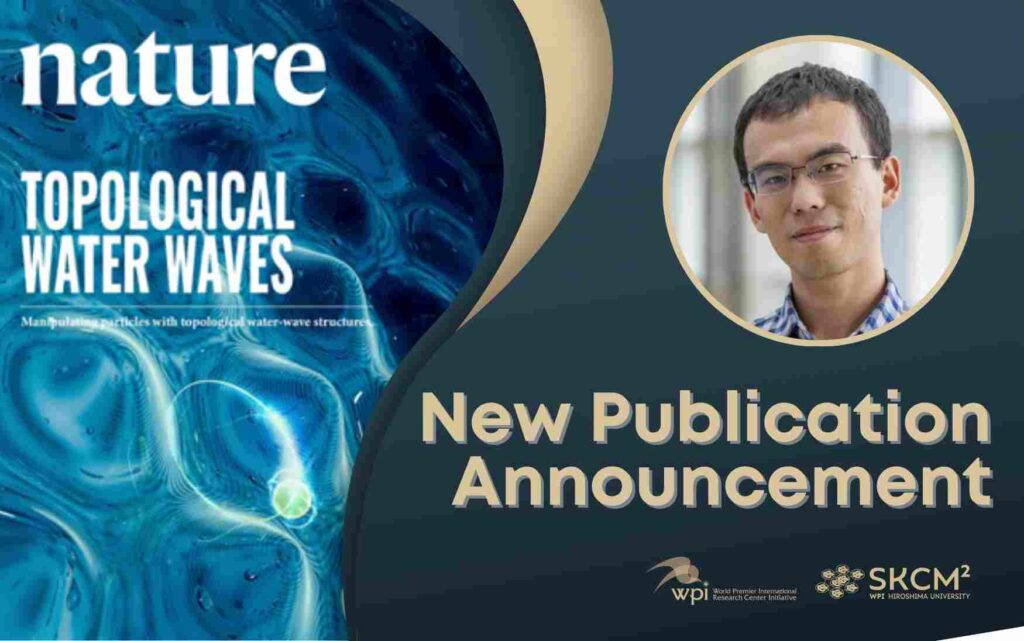Discovering topological structures in water
Fig. 1 An international research team, led by Ikerbasque Professor Konstantin Bliokh (upper-right) at DIPC Spain, Nanyang Assistant Professor Yijie Shen (mid-right) at NTU Singapore and Affiliate Member of WPI-SKCM² Hiroshima University, and Professor Lei Shi (bottom-right) at Fudan University China, discovered topological water waves and harnessed them to manipulate particles.
Imagine a world where the most advanced concepts in physics are not just confined to high-tech labs or theoretical equations, but can be found in something ordinary and familiar—water—the source of human life. This is not a fantasy, but a fascinating reality that has recently been unveiled by groundbreaking research, Topological water-wave structures manipulating particles, which was recently published in Nature. The concepts of topology, topological structure or topological physics, once considered an esoteric branch of mathematics and physics, are now making waves—literally—in our everyday lives.
In the world of topology, a mug and a donut are indistinguishable. This mind-bending perspective has sparked some of the biggest breakthroughs in modern physics. The 2016 Nobel Prize in Physics recognized the role of topology in understanding exotic phases of matter. Since then, researchers have uncovered topological structures in various physical systems, from Möbius strips in light fields to vortex patterns in electron, neutron, and atomic waves. These discoveries have deepened our understanding of both quantum and classical systems, leading to potential applications in topologically protected information processing and wave-based technologies.
Until now, topological wave structures had never been demonstrated in water. An international research team—including Assistant Professor Yijie Shen (Nanyang Technological University (NTU), Singapore and Affiliate Member of WPI-SKCM² Hiroshima University), Professor Konstantin Bliokh (Ikerbasque Professor, DIPC, Spain), and an experimental physics group led by Professor Lei Shi (Fudan University, China)—has achieved a groundbreaking discovery.
For the first time, they experimentally generated key topological structures in water waves, including skyrmions, merons, Möbius strips, and vortices with different topological charges. Beyond this breakthrough, they also demonstrated how topological water waves can manipulate floating particles, revealing a connection between wave topology and the spin-orbital motion of particles (Fig. 1).
“To the best of our knowledge, the controllable manipulation of particles with topologically-structured waves was not discussed theoretically nor observed experimentally. We did the first step in water waves, and our results open up a new platform for the study of general topological wave-matter interactions,” said co-author Shen.
This work, published in the journal Nature in February 2025, opens a new chapter for both wave mechanics with the potential to revolutionize fields such as microfluidics and biomedical engineering, and for the exploration of diverse topological structures, topological physics, and new avenues in wave–matter interactions that will have ripple effects across fields in science.
The Hidden World of Topological Water Waves
When you think of water waves, you might picture gentle ripples on a pond or the crashing waves of the ocean. But beneath this familiar surface lies a world of complex patterns and structures.
The team revealed that intricate topological structures can be precisely engineered in water. By carefully interfering plane waves on a water surface, they have created patterns with nontrivial topological characteristics. One striking example is the formation of a phase vortex—a point of zero amplitude where the phase of the wave field wraps around in a manner described by an integer topological charge (Fig. 2) — created by an infinite set of plane waves and controlling the delay of their oscillations. This discovery demonstrates that structured water waves can encode and manipulate topological information, paving the way for new applications in fluid dynamics, microfluidics, and wave-based information processing.
Fig. 2: Interference of plane waves can create topological structures by water spin, polarization, velocity and displacement. a, A single plane wave propagating along the x axis carrying non-transverse polarization and transverse spin. b, Interference of several plane waves with the same frequencies and amplitudes but with wavevectors in different directions, which can carry complex vector textures.
Beyond phase vortices, the researchers also uncovered even more complex topological formations. They demonstrated the emergence of skyrmions and merons—structures where water particle displacement vectors point in all possible spatial directions within a unit cell. These configurations are reminiscent of those found in quantum systems and could provide valuable insights into the underlying principles of topological phenomena.
From Mysterious Topologies to Magical Wave Manipulation
With fine control over the topology of water, the researchers engineered complex water wave patterns that act as microscopic “traps,” allowing them to manipulate particles with exceptional precision. These traps were created using a hexagonal array of the water-wave source to generate wave vortices that could trap particles at their centers. By further manipulating the wave patterns using a circular wave source, they also generated Bessel-type vortices with distinct topological charges for more control over the particle trapping, trajectories, and orbital and spinning motions [Fig. 3]. While topological wave structures have been observed in various physical systems, their ability to interact with and manipulate particles had never been explored—until now.
Figure 3. Manipulating water-wave skyrmions and Möbius strips and transferring wave topological structure to spin-orbital motion of real particles.
A New Era in Physics: Harnessing Water Waves for Scientific Discovery
For the first time, researchers have demonstrated that water waves, like their optical and acoustic counterparts, can be engineered to create stable, controllable topological structures. This topological water wave system can be controlled to manipulate particles ranging from small foam fragments to ping-pong balls, as demonstrated in their experiments, and could potentially extend to colossal oceanic waves. This control complements optical and acoustic waves that primarily operate at micron and millimeter scales.
“Our work shows that all of these phenomena are naturally implemented in water-surface (gravity and capillary) waves. This provides a novel framework for smart control and use of structured water waves. Most importantly, while observations of topological wave forms in optics and acoustics were considered as an important achievement per se, without any noticeable applications, water-wave manipulations of floating particles demonstrated in our work open the avenue for numerous applications in hydrodynamics and microfluidics,” said Bliokh.
While this discovery is groundbreaking for water wave research, its implications extend far beyond fluid dynamics in the ability to understand wave-matter interactions. The researchers envision broad applications across fields such as photonics and fundamental physics.
“We have only taken the first step; there are countless possibilities yet to be explored,” said Shen.
He highlighted the impact of this research on light-matter interactions, emphasizing its potential applications in optical trapping and structured light technologies:
“Our results open up a new platform for general topological wave-matter interactions, especially for advanced optical tweezers and particle trapping by structured light. The diverse topologies of light waves will play important roles in robust control of multi-degree-of-freedom motion of trapped small objects for revolutionizing both fundamental and applied science of light-matter interaction.”
Shi, meanwhile, linked the findings to fundamental physics, suggesting that these topological water waves may provide insights into the behavior of elementary particles:
“I believe that the law of spin-orbital motion of floating particles controlled by topologies of water waves is inextricably linked to the spin states of elementary particles in fundamental physics. More in-depth research will continue to explain more general laws, how, exactly, the topologies of waves coupled to the spin and orbit of particle behavior, which is likely to inspire the discovery of new physical fields, new particles in fundamental physics, even the grand unified theory of the universe.”
This groundbreaking research, published in Nature, marks a significant leap in fluid mechanics and wave-matter interactions. By demonstrating how topological water waves can manipulate particles, the researchers have opened new pathways for applications in hydrodynamics, microfluidics, and beyond. More than a scientific breakthrough, this discovery sparks imagination and fuels future innovation. As research in this field advances, the possibilities for real-world impact are as vast as the waves themselves.
Media Contact
For inquiries regarding this study, please contact:
Yijie Shen
Assistant Professor, Nanyang Technological University Singapore
Affiliate Member of WPI-SKCM² Hiroshima University
E-mail: yijie.shen_at_ntu.edu.sg



